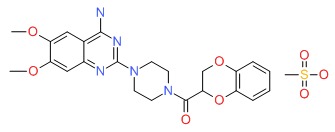NCBI Bookshelf. A service of the National Library of Medicine, National Institutes of Health.
LiverTox: Clinical and Research Information on Drug-Induced Liver Injury [Internet]. Bethesda (MD): National Institute of Diabetes and Digestive and Kidney Diseases; 2012-.

LiverTox: Clinical and Research Information on Drug-Induced Liver Injury [Internet].
Show detailsOVERVIEW
Introduction
Doxazosin is a nonselective alpha-1 adrenergic antagonist (alpha-blocker) used in the therapy of hypertension and benign prostatic hypertrophy. Doxazosin is associated with a low rate of transient serum aminotransferase elevations, but has not been linked to instances of clinically apparent acute liver injury.
Background
Doxazosin (dox ay' zoe sin) was the third alpha-1 adrenergic antagonist to be approved for use in the United States and is still widely used for therapy of hypertension and benign prostatic hypertrophy. Doxazosin inhibits alpha-adrenergic receptors present on smooth muscle in arterioles (so-called alpha-1b adrenergic receptors) as well as in those in the bladder neck and prostate (alpha-1a adrenergic receptors). The inhibition of alpha-adrenergic tone in blood vessels causes relaxation of arteriolar resistance and lowering of the blood pressure. The effects of the agent on smooth muscle of the bladder and prostate causes improvement in urine flow in men with partial obstruction due to benign prostatic hypertrophy. Doxazosin was approved for use in the United States in 1990, and currently more than 5 million prescriptions are filled yearly. Doxazosin is still used for treatment of hypertension, although rarely as a first line agent and usually in combination with other antihypertensive drugs. Doxazosin is available in tablets of 1, 2, 4 and 8 mg generically and under the trade name Cardura. Doxazosin is usually started at a dose of 1 mg once daily, with increase in the dose based upon tolerance and clinical response to an average of 4 to 8 mg in one daily dose. Higher doses can be used in treating hypertension. An extended release formulation of doxazosin is also available in doses of 4 and 8 mg (Cardura XL). Side effects include dizziness and syncope (particularly with the initial dose), fatigue, headache, palpitations, impotence, incontinence and gastrointestinal upset. Rare, but potentially severe adverse reactions include severe postural hypotension, floppy iris syndrome and priapism.
Hepatotoxicity
Doxazosin has been associated with a low rate of serum aminotransferase elevations that in controlled trials was no higher than with placebo therapy. These elevations were transient and did not require dose modification. No instances of clinically apparent acute liver injury due to doxazosin have been published in the literature, but reports of cholestatic hepatitis have been received by the sponsor. Among the alpha adrenergic receptor antagonists, the most frequently implicated agent in causing liver injury has been alfuzosin with only single, and not well documented cases linked to other alpha blockers. Thus, acute symptomatic liver injury due to doxazosin is quite rare, and severe hepatotoxicity must be exceeding rare, if it occurs at all.
Likelihood score: E* (unproven but suspected rare cause of clinically apparent liver injury).
Mechanism of Injury
The cause of the minor serum aminotransferase elevations associated with doxazosin is not known. Doxazosin is extensively metabolized by the liver and generation of a mildly toxic intermediate is a possible explanation.
References on the safety and potential hepatotoxicity of doxazosin and other alpha-blockers are given in the Overview on Alpha-1 Adrenergic Receptor Antagonists.
Drug Class: Antihypertensive Agents, Benign Prostatic Hypertrophy Agents
Other Drugs in the Subclass, Alpha-1 Adrenergic Receptor Antagonists: Prazosin, Terazosin
PRODUCT INFORMATION
REPRESENTATIVE TRADE NAMES
Doxazosin – Generic, Cardura®
DRUG CLASS
Antihypertensive Agents
Product labeling at DailyMed, National Library of Medicine, NIH
CHEMICAL FORMULA AND STRUCTURE
| DRUG | CAS REGISTRY NUMBER | MOLECULAR FORMULA | STRUCTURE |
|---|---|---|---|
| Doxazosin | 77883-43-3 | C23-H25-N5-O5.C-H4-O3-S |
 |
- Review Terazosin.[LiverTox: Clinical and Researc...]Review Terazosin.. LiverTox: Clinical and Research Information on Drug-Induced Liver Injury. 2012
- Review Alfuzosin.[LiverTox: Clinical and Researc...]Review Alfuzosin.. LiverTox: Clinical and Research Information on Drug-Induced Liver Injury. 2012
- Review Prazosin.[LiverTox: Clinical and Researc...]Review Prazosin.. LiverTox: Clinical and Research Information on Drug-Induced Liver Injury. 2012
- Review Doxazosin: a new approach to hypertension and benign prostatic hyperplasia.[Br J Clin Pract. 1996]Review Doxazosin: a new approach to hypertension and benign prostatic hyperplasia.Pool JL. Br J Clin Pract. 1996 Apr-May; 50(3):154-63.
- Review Alpha 1 Adrenergic Receptor Antagonists.[LiverTox: Clinical and Researc...]Review Alpha 1 Adrenergic Receptor Antagonists.. LiverTox: Clinical and Research Information on Drug-Induced Liver Injury. 2012
- Doxazosin - LiverToxDoxazosin - LiverTox
Your browsing activity is empty.
Activity recording is turned off.
See more...